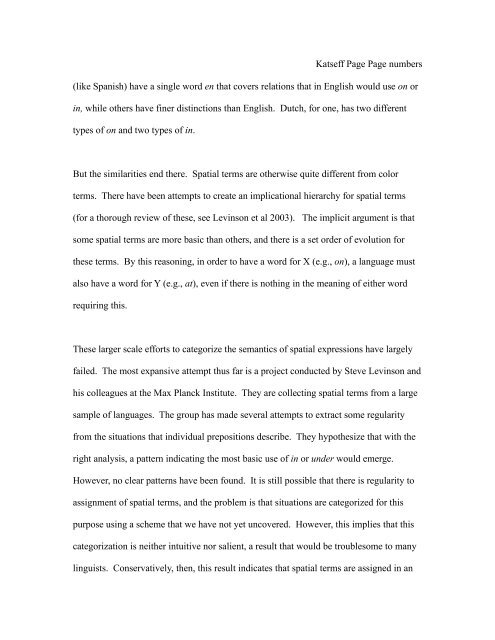The case of pidgin and creole languages - Linguistics
The case of pidgin and creole languages - Linguistics
The case of pidgin and creole languages - Linguistics
You also want an ePaper? Increase the reach of your titles
YUMPU automatically turns print PDFs into web optimized ePapers that Google loves.
Katseff Page Page numbers<br />
(like Spanish) have a single word en that covers relations that in English would use on or<br />
in, while others have finer distinctions than English. Dutch, for one, has two different<br />
types <strong>of</strong> on <strong>and</strong> two types <strong>of</strong> in.<br />
But the similarities end there. Spatial terms are otherwise quite different from color<br />
terms. <strong>The</strong>re have been attempts to create an implicational hierarchy for spatial terms<br />
(for a thorough review <strong>of</strong> these, see Levinson et al 2003). <strong>The</strong> implicit argument is that<br />
some spatial terms are more basic than others, <strong>and</strong> there is a set order <strong>of</strong> evolution for<br />
these terms. By this reasoning, in order to have a word for X (e.g., on), a language must<br />
also have a word for Y (e.g., at), even if there is nothing in the meaning <strong>of</strong> either word<br />
requiring this.<br />
<strong>The</strong>se larger scale efforts to categorize the semantics <strong>of</strong> spatial expressions have largely<br />
failed. <strong>The</strong> most expansive attempt thus far is a project conducted by Steve Levinson <strong>and</strong><br />
his colleagues at the Max Planck Institute. <strong>The</strong>y are collecting spatial terms from a large<br />
sample <strong>of</strong> <strong>languages</strong>. <strong>The</strong> group has made several attempts to extract some regularity<br />
from the situations that individual prepositions describe. <strong>The</strong>y hypothesize that with the<br />
right analysis, a pattern indicating the most basic use <strong>of</strong> in or under would emerge.<br />
However, no clear patterns have been found. It is still possible that there is regularity to<br />
assignment <strong>of</strong> spatial terms, <strong>and</strong> the problem is that situations are categorized for this<br />
purpose using a scheme that we have not yet uncovered. However, this implies that this<br />
categorization is neither intuitive nor salient, a result that would be troublesome to many<br />
linguists. Conservatively, then, this result indicates that spatial terms are assigned in an

















